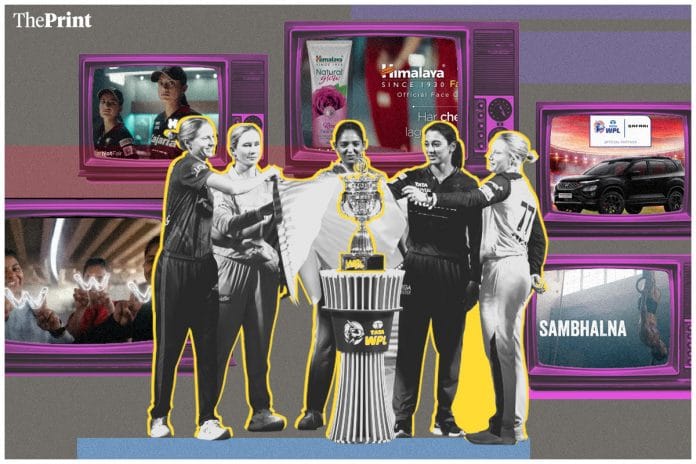New Delhi: If ads and brands on live TV are any indicator of the stature and collective perception of a sport or tournament, the commercials in between overs at the just concluded inaugural Women’s Premier League do tell a story — of market confidence in the women’s game, a gender lens at play and an experiment for the advertisers that has just begun. And when legacy brands such as Pepsi and Coke give cricket tournaments in India a miss, it’s also a reflection of the distance between money and a game that’s still arriving, commercially.
At WPL, a set of commercials also made it look like an elongated Women’s Day campaign for most brands.
The organisers roped in 35 official advertisers for the first edition, mostly women-centric brands such as Navyasa, Mia by Tanishq, Vega Beauty and Lotus Herbals. Even gender-neutral brands such as Puma and Tata Safari leveraged WPL to make it the ‘super bowl’ of women-centric campaigns.
Advertisers, however, skipped launching new products or big campaigns in the much-anticipated tournament. Probably a sign of the low market confidence in a sporting event that is just starting off.
While there is no data available that provides a gender break up of WPL viewership, advertising experts have said in the past that it was a ‘safe assumption’ that the tournament would attract more women audiences to television. That explains why the tournament became a natural place for women-centric brands to encash popularity.
The barrage of women-centric campaigns, said a senior Gurugram based advertising professional, shows how advertisers didn’t see the tournament just as a sporting event. “IPL is viewed as a more generic tournament with a broader reach. Whereas for WPL, people thought viewers would be interested in watching content centered around women’s empowerment only. They didn’t see it as a platform with a universal reach,” he told ThePrint over the phone.
Women-centric campaigns can also be attributed to an advertisers’ tendency to side with the ‘flavour of the season,’ said Shubho Sarkar, veteran ad man and consultant. “Since it’s the first time this kind of a women’s cricket tournament was being organised in India, it was easy to attach yourself to the notion of celebrating women. If it was a mix-team professional league, ads would’ve centered around equality, fusion, participation,” he added, saying “it’s always an advertiser’s tendency to pick up the novelty factor and tom tom it.”
Also read: WPL historic but not without these commentators, umpires—’Sachin on microphone’, fun umpiring
Notable campaigns
Calling itself the ‘proud’ official partner of the Women’s Premier League, Tata Safari used Nike-like language in their ads, featuring confident women who are set to rule the world from the driving seat of their cars. The ad film for their campaign wasn’t centered around cricket, rather women in sports in general.
Himalaya’s #NotFair ad caught a senior ad professional’s eyes, for its 360-degree campaign. “It started with an activation– Bangalore players took over the pitch with #NotFair written on their helmets. Slowly it was revealed by Himalaya that the women were talking about Himalaya Rose Facewash, which says beauty is not about colour. They built good intrigue with it,” he said.
Sarkar also underlined the difference in the stature of brands advertising during WPL. There were fewer ed-tech startups and international brands. The timing of the tournament also kept soft drink legacy brands at bay, even though ad rates were much more affordable than IPL. “It could’ve been the perfect opportunity for a brand like Pepsi to launch a cool youth-centric campaign centered around women, but the soft drink season is not here yet, so cola brands seem to have not participated,” said the senior advertising professional quoted above.
Sarkar pointed out that legacy brands tend to stay away from experimental events, and that in a cash-strapped economy, they are even more conscious of where to spend their money. “Not like legacy brands were completely absent, but they wouldn’t generally spend their money on something that hasn’t been tried and tested. Ad slots were cheaper, yes, but nobody knew how many eyeballs ads would attract,” Sarkar told ThePrint.
Also read: Delhi has given up fixing monkey problem. Courts, committees, tenders—nothing’s working
Encouraging opening season
While female-driven campaigns dominated ad story lines, Sonata Software, Dream 11, JSW Paints, Apar Industries, MPL Striker, GoNoise, were some of the gender-neutral brands that advertised during the tournament.
Tata Women’s Premier League was a smash hit. It clocked a viewership of more than 10 million new viewers, according to a press release by Viacom–the highest for any women’s sporting tournament in the world. Streamed for free on the JioCinema app, matches had an average watch time of 50 minutes per user.
In contrast, the TV viewership of the Indian Premier League alone was 229 million last year. The difference in viewership had a significant bearing on advertising rates too. While a 10-second ad spot during IPL can cost anywhere between Rs 10-15 lakhs, WPL ad spots were reportedly sold for Rs 1-1.25 lakh.
However, advertisers said that for the first edition of the tournament, the response was encouraging and in no way can be compared to the Indian Premier League.
“IPL is in its fifteenth season, it was the first for the women’s league, but its future looks bright. Franchise sport, not only in cricket, has been a tremendous success in India. This year’s popularity will now work as a blueprint for brands to follow in the future,” Sarkar said.
(Edited by Anurag Chaubey)






